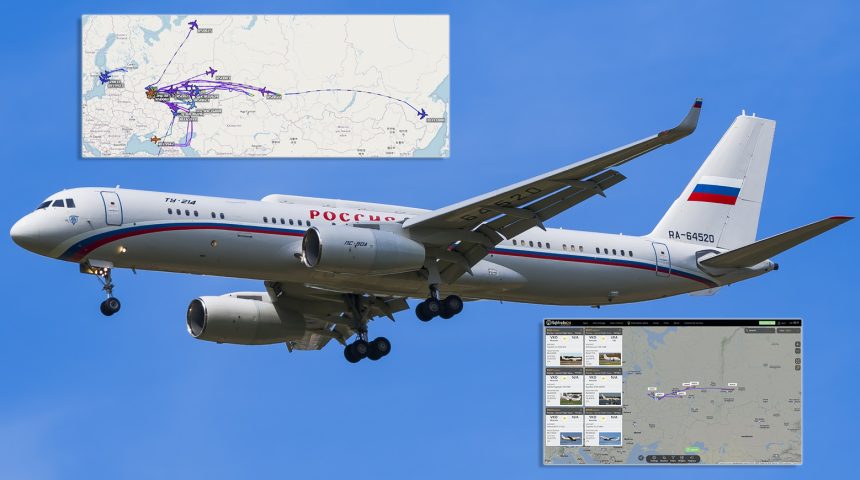Social media went on a frenzy when more than a dozen aircraft (tracking online) departed from Moscow and nearby airports heading prevalently to the East. Many of those flights have since returned back to the Russian capital.
Something not really usual was spotted in the last few hours on flight tracking websites, with more than a dozen of flights of the Russian Air Force and the Rossiya Special Flight Detachment tracking while leaving Moscow and the nearby airports in various directions, mainly towards the East. Such surge of flights in a short time, as expected in this time of international crisis following the ongoing invasion, is rounding up many theories about what is really happening in Russia.
This volume of aircraft movements might mean something but could also mean nothing at all, since no one knows the real reason of these flights. Among the prevailing wild theories online we can find an evacuation of Russian government officials from Moscow, an emergency meeting, a nuclear war training or even a nuke alert. Instead of speculating about the reason, let’s just talk about the facts and try to understand what we are seeing.
What’s going on here?
-RuAF Tupolev Tu-204-300 RSD3
-RuAF Sukhoi Superjet 100-95B RSD71
-RuAF A319-115CJ RSD72
-RuAF An-148-100E RSD73
-RuAF Ilyushin Il-96-300PU RSD74
-RuAF Tupolev Tu-214PU RSD78
-RuAF Tupolev Tu-214SR RSD79
-RuAF SuperJet 100-95B RSD80 pic.twitter.com/FcmbtpbyNZ
— Manu Gómez (@GDarkconrad) March 17, 2022
I put together an animation of the recent movements of all RSD* planes in recent hours. pic.twitter.com/c6QhqsBkja
— Bunker Punx 🛹بونكر بانكس (@ikoosh) March 17, 2022
First of all, let’s talk about their flight directions.
As we can see in the screenshots, the aircraft are headed mainly to the East of the country. A simple reason for that is the current ban of Russian flights from all European countries so, even if those aircraft were to fly internationally, they would have to fly around all the forbidden airspace. As a matter of fact, only a few of those flights left the country, with a couple of Il-76s going to Kaliningrad and a Tu-154 going to Syria.
Another detail regards the aircraft involved, which are standard cargos, VIP aircraft and special mission aircraft. Among those are the Tu-214PU and Il-96-300PU airborne command posts and the Tu-214SR communication relay aircraft. Their specific presence in flight is not unusual, as they can often be tracked online. Some noted that such a number of flights is not unusual too, although they are spread throughout the day in a longer timeframe.
And I suppose I still feel the same way.
I would see on an average weekday 15-20 aircraft. Back then, I had fewer codes to my database. This could even be attributed to that lack of data. pic.twitter.com/HsG85VDGgB
— Evergreen Intel (@vcdgf555) March 17, 2022
Now some of those Rossiya flights are returning to Moscow or have already arrived.
This behavior happens EVERY DAY. The only thing that has changed is their direction, starting off towards the east, due to air restrictions.
In short, I wouldn’t run off to your bunker over this. pic.twitter.com/3QbpQvYfQL
— Evergreen Intel (@vcdgf555) March 17, 2022
Interestingly, many of these flights already returned back to their departure airfields. Among the destinations observed there are Novosibirsk, Kaliningrad, Kurgan, Kogalym, Tyumen, Omsk, Ufa. Some of those aircraft landed and departed again some time later, some instead appeared to begin some holding orbits, while a couple of Il-96s are on some longer-range flights.
One of the reasons all those flights sparked so much interest is the fact that a part of those aircraft belong to Rossiya. The Rossiya Special Flight Detachment is in charge of the special mission aircraft, such the Tu-214SR, Tu-214PU and Il-96-300PU mentioned earlier in this story, and of the VIP transport aircraft. The special unit flies the Russian equivalent of the more famous U.S. VC-25, E-4B Nightwatch and E-6B TACAMO.
Russian Air Force Tupolev Tu-214PU
airborne command post RSD78 inbound Novosibirsk. pic.twitter.com/RY8pJ3GXzq
— Manu Gómez (@GDarkconrad) March 17, 2022
RuAF Tupolev Tu-214SR RSD79 (airborne communications relay) circling near Kurgan. pic.twitter.com/iBssPNqKch
— Manu Gómez (@GDarkconrad) March 17, 2022
Since the unique missions of this unit, its flights always spark some interest online. However, it should be noted that they do not always transmit their transponder signal in the clear, meaning that in some cases they are “invisible” on flight tracking websites. As we noted in multiple occasion when NATO aircraft were visible online, if they are transmitting their info, they know that their track is visible by everyone online and they want to be seen. Whatever the reason for today’s missions, it seems likely that they wanted to be seen (or didn’t need to hide their tracks).
“It’s not a secret we are here, and we don’t want it to be a secret,” Tactical Director aboard NATO E-3 AWACS. Pretty clear no?
— David Cenciotti (@cencio4) March 11, 2022









